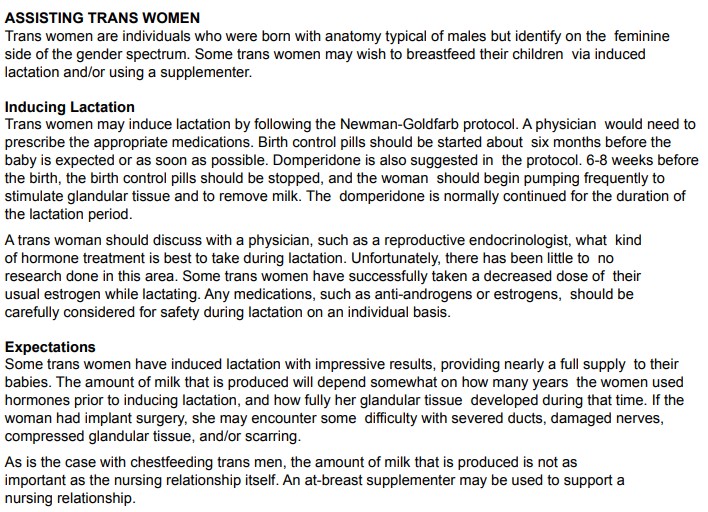
[Part 2]

|
Nutritional Value of Induced Milk Milk released by a mother during the first few days of lactation after giving birth is called colostrum; it is richer in proteins, minerals, and immunoglobulins and is lower in calories and fat than the mature milk that develops over the following few weeks. The level of fats, lactose, and B vitamins gradually increases in breast milk during the first month of lactation. Mature breast milk is rich in the mother's white blood cells and hormones and substances such as immunoglobulins, which protect the infant against bacteria and other infectious agents.The milk brought in by inducement skips the colostral phase, instead it more closely resembles transitional and mature breast milk. It is thus not ideal for new-born babies, but studies of non-maternal women nursing after induced lactation indicate that that their infants are well-nourished. However, it must be noted that many women felt they were only providing about 50-70% of the nutrition their babies needed with breast milk alone. If a transsexual woman is nursing it is therefore also very likely that she will be able to produce only a portion of the breast milk the baby needs, and it will be necessary to boost the baby's milk intake with formula. For this a Supplemental Nursing System (SNS) is valuable alternative to the traditional bottle. The device consists of a plastic pouch to hold breast milk or formula and attached thin, flexible tubes that run down each breast to the nipple. Since the baby takes both nipple and tube into his mouth when he suckles, he benefits from all the breast milk that is available.
The number of transwomen adopting babies or having a baby via a surrogate mother other or complex arrangement is increasingly dramatically. In some instances, the transwoman is technically the baby's father as her sperm was used to impregnate an egg. There are now numerous cases where a baby's 'mother' from its birth or early adoption is a transwoman. Many of these mothers want to breast feed their baby but can't. However, a close approximation to breastfeeding - for both the baby and the mother - can be achieved using a Supplemental Nursing System (SNS). Three examples:
Achieving lactation is a challenge for MTF transsexuals (do you early want to wake up at 3:00 am to use a breast pump?), but it is quite possible as indicated at the start of this article for a transwoman to breast feed a baby.
In 2010 the Oprah Winfrey programme featured Dr Christine McGinn - the "Mum who fathered who own children". Christine is a lesbian MTF transsexual woman, before SRS she had a sperm sample frozen and this was used for an IVF procedure which happily resulted in her female partner giving birth to twins. Christine was able to breastfeed to the babies, she says: "A lot of women who adopt go through a regimen of hormones before they have their child, and that enables them to breastfeed by the time they get their child. So I just did the same protocol. It's basically simulating pregnancy with hormones, and since I transitioned 10 years ago, I had enough breast development where it was basically the identical situation."
 In 2016 I was also contacted by a 29-year-old transwoman, newly married and with an adopted baby. She told me: "[The baby] is wonderful and I was at his birth... I am breastfeeding him through induced lactation. With what I pumped and stored in advance he had only breast milk for one month.... now he has breast milk and formula. I feel great and life is very calm and lovely these days. Things in my life are so satisfying now. Now all I have to do is learn how to enjoy it!"The same woman seems to heve featured in an article by Zil Goldstein, and Dr. Tamar Reisman of the Mount Sinai Center for Transgender Medicine and Surgery in New York, published in the January 2018 edition of Transgender Health. This describes how a 30-year old transgender woman approached Reisman and Goldstein at their clinic - "the woman was pleasant, well-nourished, and her breasts were well-developed".  They learnt that her partner was pregnant
but didn't want to breastfeed, and that she was hoping to take on the
role. The clinic then conducted probably the first professionally
supervised medical study in to induced lactation in a transgender woman.
The
unnamed patient was able to achieve sufficient breast milk volume to be
the sole source of nourishment for her child for six weeks after birth.
Her treatment essentially followed the basic framework already described
for induced lactation: They learnt that her partner was pregnant
but didn't want to breastfeed, and that she was hoping to take on the
role. The clinic then conducted probably the first professionally
supervised medical study in to induced lactation in a transgender woman.
The
unnamed patient was able to achieve sufficient breast milk volume to be
the sole source of nourishment for her child for six weeks after birth.
Her treatment essentially followed the basic framework already described
for induced lactation:
Key points of the study include:
A fairly significant news story in 2020 in South America was Columbian pre-SRS transwoman Danna Sultana having a baby boy - Ariel - born in July 2020. Ariel was actually gestated using Danna's sperm by her transmale husband Esteban Landrau, who was also pre-SRS but had subcutaneous mastectomy surgery to remove his breasts before becoming pregnant. At birth Ariel was presented to Danna rather than Esteban as his "Mama", and she was soon "feeding him", presumably via bottle and formula milk. The very confusing articles subsequently published appear to often be due to inexperienced journalists assuming that Danna's claim to be the mother equated to that of a cis-woman - rather than a deliberate attempt to mislead. In 2023, Naomi in the UK published on social media photos and commentary about breast feeding her baby - which caused some controversy. A pre-GCS transwoman, Naomi says that after disscusions with her fiancée, who also has two children from a previous marriage, they decided that she was best placed to feed the baby: "My fiancée wasn't really able to keep up a supply of milk, both due to some troubles with her body as well as working late nights at the hospital, so there was no time for her to keep an established supply. But I have a very flexible schedule with my work as a researcher, so I was able to essentially produce the milk our child was on. It ended up working out really well and had been something that I always wanted to do as a mother."
A new-born baby needs about 500ml of milk a day, increasing to 1000ml by six months. After the baby was born, Naomi found that she was able to produce around 150ml of breast milk per day over five pumping sessions, this had to be supplemented by formula milk to make up the gap. Two weeks after the birth, she also started breastfeeding once or twice a day “with good success”. Naomis says that being able to nourish her child was a life-changing and powerfully affirming experience. "It’s made me feel close to my child in such a way that’s so motherly, ... it’s natural and it feels so right to be able to provide for my child in that kind of way.”  Seek Support Seek SupportTransgender women pursuing induced lactation should seek to be referred to a lactation consultant to optimize breast stimulation techniques, develop pumping schedules, support in infant latching and chestfeeding positions and for adequate support. At some point in the early 2020's, the UK's NHS accepted and started to medically support and encourage breastfeeding by MTF transwoman. It has partnered with the Queer Birth Club to provide advice and training to midwifes, nurses and patients. It now promotes breastfeeding by transwomen and claims that it is “transmisogyny” to say that the milk produced by biological men is “less”.
For a person born male to breastfeed, they must develop milk-producing glands by taking estrogen and progesterone hormones. A drug is then required to lactate, such as domperidone, which is often prescribed to women struggling to breastfeed, and helps to stimulate the production of prolactin – a separate hormone that tells the body to produce milk. Prolactin and oxytocin, the hormones which govern lactation, are pituitary, not ovarian hormones (such as oestrogen). There are currently no human prolactin medications available, but in 2001 I spotted whilst doing some research that the anti-nausea drug domperidone (brandname Motilium) was described as having the side effect of increasing production of prolactin by the pituitary gland - which is found on both genetic men and women. Prolactin is the hormone which stimulates the cells in a mother's breast to produce milk, and I thus speculated that taking domperidone could help transwomen to induce lactation by effectively tricking their body and breasts into thinking that she was pregnant.
In the years since then, Domperidone has become regularly prescribed to help breastfeeding mothers, and importantly a 2015 study shows that it doesn’t “substantially alter the nutrient composition”. I was recently amused to read a 2018 medical article which described their prescription of Domperidone as a breakthrough development in promoting lactation in transgender women. Domperidone, also known by the brand name Motilum, was not intended for this, but is prescribed off-label by doctors, despite the manufacturer, Janssen, itself recommending against it because of possible side effects to a baby’s heart. The patient leaflet for Motilium says: “Small amounts have been detected in breastmilk. Motilium may cause unwanted side effects affecting the heart in a breastfed baby. [It] should be used during breastfeeding only if your physician considers this clearly necessary.” USHT believes the practice is safe, adding that hospital staff “advise any parent who is taking medication (for whatever reason) to seek advice on the possibility of that medication being transferred to the baby through breastfeeding and also the health implications for the baby”.  In many countries domperidone tablets are available without
a prescription. A typical dose is 20 milligram's (two 10 mg tablets)
four times a day, i.e. about every 6 hours. After starting domperidone, it may take three or four days before any effect is noticed,
though some women have nipples leaking milk within 24 hours. It appears to take
two to three weeks to get a maximum effect. Most women take
domperidone for 3 to 8 weeks, but women who are nursing adopted babies
usually take the drug continuously in order to maintain lactation.
Domperidone can cause stomach or digestive
upsets, but this is usually due to taking an excessive dose. In many countries domperidone tablets are available without
a prescription. A typical dose is 20 milligram's (two 10 mg tablets)
four times a day, i.e. about every 6 hours. After starting domperidone, it may take three or four days before any effect is noticed,
though some women have nipples leaking milk within 24 hours. It appears to take
two to three weeks to get a maximum effect. Most women take
domperidone for 3 to 8 weeks, but women who are nursing adopted babies
usually take the drug continuously in order to maintain lactation.
Domperidone can cause stomach or digestive
upsets, but this is usually due to taking an excessive dose.Another related but older medication is metoclopramide (brand names Maxeran and Reglan), this is also known to increase milk production but it has frequent side effects which have made its use for many nursing mothers unacceptable (fatigue, irritability, depression). But in general domperidone is much preferable; it has fewer side effects because it does not enter the brain tissue in significant amounts. Genetic women trying to start lactation are advised that prolactin enhancing drugs need only be started only after the ending of any oestrogen treatment as oestrogen, particularly those types found in contraceptive pills, retard the start of lactation. However, many transsexual women seem to gain considerable benefits from the breast developing effects of prolactin even if it's not initiating lactation because of their high oestrogen intake, and thus should not be deterred from early use. Some women find that herbal seed capsules such Blessed Thistle and Fenugreek help increase their lactation, and these are very commonly taken.
Hormone Regimen I have been repeatedly asked for typical regimen for hormonal stimulation of the breast for lactation. I am not a medical practitioner, and there are many factors that must be taken into account when determining the best regime and these must all be discussed with your doctor. As an example only, and derived from just limited evidence, the following daily regimen may be appropriate for a post-SRS woman under 40 years: 1 x Premarin tablet from Wyeth-Ayerst, containing 1.25mg Conjugated Estrogens, twice daily
Many years after arriving at the above regimen, I found on social media a transwoman who claimed to be successfully breastfeeding her partners baby after using the following regimen in the final few months before birth: 1. Continued taking estrogen (estrodiol) as usual but added 200mg Progesterone daily. Maintained for 8 weeks. 2. Began breast pumping at least 8 times a day, including once around 3 am. Added 10mg Domperidone every 8 hours for a week 3. Increased Domperidone to 20 mg 4. Six weeks before due date, stopped taking estradiol (restarted at a reduced doseage) 5. Four weeks before due date, began taking Fenugreek (6120mg) and Blessed Thistle (390mg) three times a day 6. When baby arrived, ceased pumping and gradually reduced Domperidone to zero. The woman admits that after a few days she restarted taking estrogen at half the previous dose as total cessation was causing her too "feel like garbage [with bad] mood swings". "Attempted lactogensis" means reverting to the prior hormonal regimen in order stimulate the start of milk production and lactation, this must involve a considerable reduction in oestrogen and progesterone hormone intake, in pre-SRS women it may require a reduction to less than their normal regimen. If a baby is to be nursed then medical advice should be sought as to what hormones can still be safely taken and in what dosage, and any anti-androgens being taken must be stopped. Prolactin-enhancing drugs should continue to be taken, e.g. 2 Motilium tablets every 6 hours, each containing 10 mg domperidone maleate. Antiandrogens may be helpful to a pre-SRS transsexual women trying to induce lactation, but they must stopped before breastfeeding. The most commonly used antiandrogens are spironolactone (brand name Aldactone), flutamide (Eulexin) and cyproterone acetate (Androcur). In the late 2010's things changed significantly when the medical profession finally decided to support the inducement of lactation in transwomen. Since then lactation regimens for transwomen that roughly mimic the hormones levels of a pregnant cis-woman have become increasingly successful and standardised. One of the best medical papers so far is Lactation induction in a transgender woman: case report and recommendations for clinical practice, published in March 2024 by Dr Jojanneke E. van Amesfoort and collaborators. The case study follows a 37-year-old transgender woman who had been on hormone therapy for 13 years. Prior to this she had had sperm frozen. After entering a relationship with a cis-woman, her partner conceived using this spermvia IVF. The patient wanted to be able to breastfeed her future infant and began a hormone-regimen to mimic pregnancy. Eventually the patient started lactating and although the production of milk was low, it was sufficient for supplementary feeding and a positive bonding experience for the patient. The diagram below summarises the mimic pregnancy the transwoman went through:
As a result of the case study, the authors suggest the following treatment regime:
The case report also underlines that lactation induction protocols commonly used for cisgender women are also very effective for transgender women. Breast PumpsIf you don't have a baby or young child to nurse then hiring or buying a good quality, fully automated, electric breast pump that closely imitates the natural rate and rhythm of a baby's suck pattern is essential in order to regularly artificially stimulate let-down and express milk. Some automatic pumps can "double pump" (i.e. pump both breasts at once) thereby increasing prolactin levels and milk production while at the same time decreasing the amount of time a pumping session takes by about half to about 15 minutes.
Breast Milk Quality A major objection to transwomen breastfeeding has been the claim that the quality of the milk can't possibly be equivalent to that of natal cis-woman, indeed it might even be dangerous to the baby because it was full of drugs. Despite the lack of evidence to support this argument, it has undoubtedly deterred many transwomen from attempting to lactate in order breastfeed their babies. In fact, the limited available evidence is very evenly balanced, with a strong possibility that breast milk produced by a transwomen who were assigned male at birth is as good for babies as that produced by a mother who has given birth.
But some experts have rejected the USHT's claims, pointing that there have been very few recent publications, the vast majority have not looked at what's in the milk itself, and overall lack of scientific studies on such side effects. Also, the 2022 study lasted for just five months, no long-term data was obtained and the sample size was very small (an inevitable result of very few potential candidates). Inducing and maintaining lactation requires:
Backlash The mid-2020's has seen a huge backlash against transgender women (i.e. born genetically XY male), some I fear is deserved. An unfortunate bilateral casualty has been the concept of transwomen breastfeeding a baby. Newspapers articles and Internet boards and forums have let loose at transwoman taking "dangerous cocktails of hormones and drugs" to induce lactation, and then forcing innocent babies to feed on the resulting "low quality milk substitute". A search of the internet certainly reveals somewhat weird pictures of bearded men "chestfeeding" babies. However, there are serious inaccuracies with this agenda. 1. The vast majority of the photos are of transmen (i.e. born genetically XX female) who before having any gender confirmation surgery decided to have a baby, and then breastfed 2. The drugs and hormones used to induce lactation in a transwoman are essentially identical to those produced in a woman's body during pregnancy and immediately after birth 3. Tests of the milk produced by a lactating woman and a lactating transwoman have found them comparable, the major difference tends to be quantity produced. Both are far superior to formula bottle feeding this doesn't provide the immunological advantages or the complex nutritional composition of breast milk. 4. The Newman-Goldfarb protocol has proved to be as effective for transwomen as it is for natal women, with many successes reported in medical papers. 5. The respected La Leche League states in a 2024 publication: 
Useful Links
A Final Note: Feedback and additional contributions to this page are very welcome, your identity will remain strictly confidential unless you state otherwise. I'm particularly interested in hearing from transwomen who have experienced secretion or expression of colostrum or milk from their breasts.
|
Last updated: 28 August, 2024